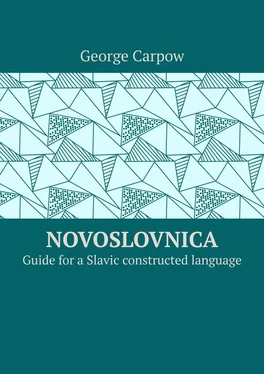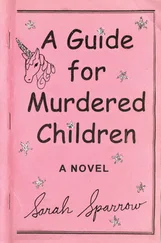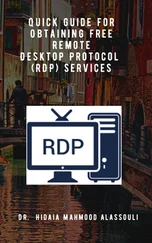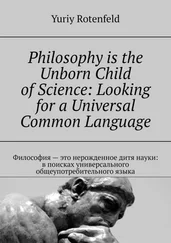Novoslovnica
Guide for a Slavic constructed language
George Carpow
© George Carpow, 2019
ISBN 978-5-0050-5083-0
Created with Ridero smart publishing system
Starting this book I would like to appreciate some persons who had great influence on me writing this book. Such a work never can be done with efforts of a single man. I am grateful to those who believed in the project for the whole development period or just for a while.
First of all I want to thank Rafail Gasparyan. I suppose without his help and collaboration this book would have never been finished. And maybe so Novoslovnica would.
I would like to thank my Macedonian friend Kristijan Cvetanovski. His trust in Novoslovnica have been making me continue my work for all these five years. And with the help of him I discovered some important points that shook the grounds of the project a bit of times.
I want to thank my American friend Harris Mowbray and my Belarusian friend Sergey Yanchenko for editing English and Russian text of the work respectively.
Also I want to thank my Czech colleague Vojtěh Merunka for his critical view on this project. This made me rethink an amount of language details. Without that I don't believe Novoslovnica would have ever become a serious project.
I would like to thank my brother Ivan Carpow who spent his time and efforts on readting this book and making comments and corrections.
Moreover, I would like to appreciate persons that keep the inspiration inside me for these years: Manol Terziev (Bulgaria), Ivan Petrov (Bulgaria), Alexandra Getsich (Serbia), Ljiljana Bradich (Serbia), Igor Achkasov (Russia).
Every language is alive – it is born, it grows up, it bares children and it dies.
The process of developing a language is unstoppable and it is cause by a lot of factors we cannot track.
What a beauty is a moment a new language appears. A lot of languages are old and appeared many years ago. However, there exist a very young ones were witnesses to be born i.e. Afrikaans (20 century), Yiddish (19 century) and extinct i.e. Prussian (18 century), Slovinian (20 century), Livonian (2013 year).
The language is naturally born doubly:
• by dialect divergence
• by two languages pidginating
The first way is much popular, though in pure form they both appear pretty rarely. This leads to differentiating of languages into a close language group.
Nevertheless, people sometime get into idea of reuniting these groups into a single language. This is not a natural way but we have examples of such a reunion. For example, modern German language was created from a group of different german languages and dialects to unite people into a single strong country. And they succeeded, so today we ahve a stable literary German language (though some region dialects still exist).
Moreover, people want to unite languages that have diverged much greater than German dialects did. It is rather enviable, though so many examples took place (Volapük, Novial). However, one of them, called Esperanto created by L.L. Zamenhof in 1887 year was very successful. Today more than 2 million people speak Esperanto and several thousand of them use it as a native language.
These examples show that the languages develop both ways – unification and divergence.
Novoslovnica as such a bridge for Slavic languages is working in direction of uniting the language. Collected expressiveness, beauty and purity of all Slavic languages, it tries to rework the idea of what a Slavic language should be.
It is not the only project in this sphere. Starting from Cyril and Methodius, Slavs continue to think about the idea of a common language when loosing the previous project in mind.
The need of a secular common language for Slavs is especially important since the twentieth century. The process of globalization is destroying weak languages and washing out a lot of root nests from others.
Novoslovnica in a row with other Slavic auxiliary language projects try to create something that Slavs could use to struggle the globalization process.
This book is for those who is interested in such an idea of a Slavic language reunion. Moreover, it reveals some historic features of our languages.
Hope you will enjoy reading this book and get something important for yourself when you finish it.
Novoslovnica is a standardized language project with strict rules in it that make the language able to be codified. Hope this will be useful for the interslavic community in developing the bridge between Slavic languages.
Whatever would be, anything you find useful in this book will make it worth writing, my dear reader.
You are welcome to write me all your wishes, comments and marks via email: support@novoslovnica.com
Best wishes, George Carpow
It would be right if we start the book with the article 1 1 G. Carpow, «Братья-славяне, или почему нам нужен новый язык.» http://culturolog.ru/ content/view/2407/6/, 2015. Accessed: 2019—0729.
that was the first on the way to Novoslovnica construction.
The Slavic world has a deep and rich history. The Slavic tribes appeared on the vastness of Europe, and during their history of growth and development they have reached an extraordinary territorial vastness of settlement. We can say that the formed tribes of the Slavs lived on a huge territory according to Europe standards: from the Elbe in the West to the Volga in the East, from the Aegean sea in the South to the Neva river in the North. Further, due to the development of Kievan Rus and the Russian state, the Slavs settled throughout Eastern Europe and Siberia. Despite all the contradictions in politics and strife, the cultural and linguistic component of the Slavs continued to be preserved. Of course, the tribes bordering on other Nations have experienced enormous cultural and linguistic pressure, including Turkic, Roman, Finno-Ugric peoples.
Despite this, the Slavs retained their cultural identity and mentality. So, we can easily understand a person from the same group (Eastern, Western, Southern) and with little difficulty can establish communication with a person from another group of Slavs. This gives us the right to talk about the brotherhood of the Slavic peoples.
Many of the Slavic peoples have sunk into Oblivion, some in very recent times. For example, the Polabian culture left with the language by the middle of the 20th century. However, most of them remained alive, and from our common efforts depends on what will be the future of the Slavs.
From modern Slavic peoples only East Slavic group had relative stability and self-sufficiency. Russian experienced several waves of foreign language intervention – Mongolian, German, French and English, from which he, generally speaking, came out the winner, in many cases enriching and diversifying its vocabulary. At the moment, the English intervention, the strongest since the Tatar-Mongolian yoke, which has withdrawn many native Russian words from our everyday life, has not ended. But Slavs do it, assimilating came, and sometimes returning lost.
The situation is different in other Slavic groups. Not possessing constant sovereign statehood, Western and Eastern Slavs were subject to constant influence other peoples. Thus, the intervention of Turkish language in the South Slavic languages and culture can be correlated with the Tatar-Mongolian yoke for Russia. After liberation from Turks, southern Slavs have become to experience Western influence, and we can to see enough a large number of borrowing from English, French and camping on p. in Bulgarian and Serbian languages.
Throughout its history, Western Slavs were constantly terrorized by the influence of Romanesque languages. So, under the onslaught of the Germans, the Slavs lost their land along the Elbe and retreated to the Oder. Thus, the influence of the Romanesque tribes was also facilitated by the adoption of the Latin alphabet by the languages of the Western Slavs, instead of a possible Glagolitic or Cyrillic. Anyway, Slavs, though, and have undergone numerous impacts on their culture, managed to keep a common language to the present day.
Читать дальше












